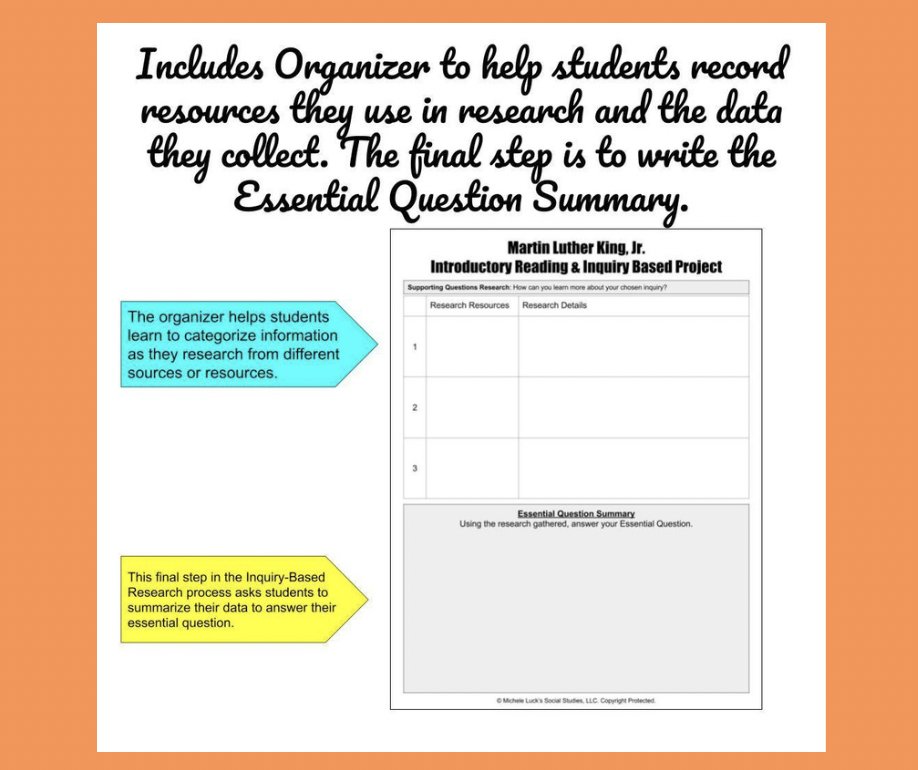One of the easiest, yet sometimes most daunting skills to teach is summary. Our students are taught how to summarize from the time they are in elementary school, but it seems they forget all of those skills the minute they walk into our classroom. But summary is vital. Not surprisingly, we use it in almost every task we assign. Students must understand the components and uses of summary before any other content or skills can be addressed.
Why is Teaching Summary Important?
Let me start with an example from my Inquiry Based Lesson Series. For students to get to the skill of inquiry, they must first be able to collect data and summarize. After reading for content, summary is the next, very important step in learning.

Standards on Summary
Most every state has a standard that addresses summarization. It may be worded in a number of different ways, but it always requires the same: teach students to take information and condense it into a synopsis of the main content. In Social Studies, this is very important. I often refer to it as finding the “big picture.” In the common standards, it states:
Determine the central ideas or information of a primary or secondary source; provide an accurate summary of how key events or ideas develop over the course of the text.
Rejoice! We have been doing this one for ages! Reading for meaning and summarizing have been staples in the Social Studies classroom since Plato and Socrates were professing on the hillsides!
Implementing Summarization in Your Lessons
Now the challenge comes in implementing this standard without being dependent on a textbook. Just keep in mind that “primary and secondary” sources can help you meet this standard. That opens up so many doors for you:
- Turn your classroom into a “Walking Tour” and allow students to gather information from placards as they circulate from tour stop to tour stop. Students will then complete an exit activity, or even a more comprehensive assignment which asks for the summation of ideas and content learned.
- Build an archeology site in your classroom. I detailed this activity in one of my earlier blog posts, and it is a favorite among students, teachers, and administrators! One of my principals even joined in with my students, digging through my shredded paper dig site for clue cards! Purchase already created “Archeological Dig” activities or create your own. Follow up with a summary assignment to assess student learning.
- Set up Centers or Stations around your classroom to allow students to perform different tasks related to the topic on hand. Social Studies is NOT just about reading the content. Allow students to dress like the Romans, play Skittles like the Ancient Egyptians, or draw while lying on their backs like Michelangelo.
- Engage students in Response Group Activities where they are posed questions on specific topics of study or are posed a problem to solve that will help them to better understand an event in time.
- Assign Investigation or Research Projects where students can learn about a subject while having some choice and freedom in the process. These lessons can lead to a number of writing assignments, addressing many of the ELA standards. If your school allows teachers to work cross-curricularly, you can work with the Language Arts teachers to create and implement amazing student research projects.
Assessing the Standard
With each of these instructional strategies, you must remember the assessment portion of the lesson. Students MUST summarize what they have learned in the lesson. Be creative, and allow students to express this knowledge in a variety of ways from lesson to lesson or unit to unit.
Here are a few of my favorites:
- Journal or diary entries from historic figures
- Annotated and illustrated timelines
- Protest posters with thorough evaluation of the event
- Face-off perspective statements (can be done as an exit slip!)
- Political cartoons or other artistic creation
Creative Methods for Assessing Summary Lessons
Keep in mind that a summary can be done with thorough development WITHOUT words! While I used writing assignments regularly, and some quite extensively, in my Social Studies classes, I occasionally allowed my students to express their knowledge in the format with which they were most comfortable. Some of those artistic summaries were the BEST and I can remember them vividly still. Two of my favorites: A pencil and pen sketch of the Civil Rights Movement. The images leaped off the page and told an understanding that was indescribable with words. And an illustrated summary of the Middle Passage from the perspective of a rat aboard the slave ship. You can just imagine the imagery and content in both!
Again, implementing the standards in the classroom is not about requiring students to read a textbook and repeat its contents verbatim. It is all about teaching them the skills they need to read, review, process, analyze, interpret, evaluate, and apply the information from any source they see on any topic they encounter.
For a variety of interactive lessons that can help you to implement this standard, please visit Michele Luck’s Social Studies. For Walking Tours, Archeology Digs, Centers and more to get your kids out of their seats and into your content, follow THIS LINK!
And be sure to continue the Standards in Your Classroom series.

Happy Teaching!
